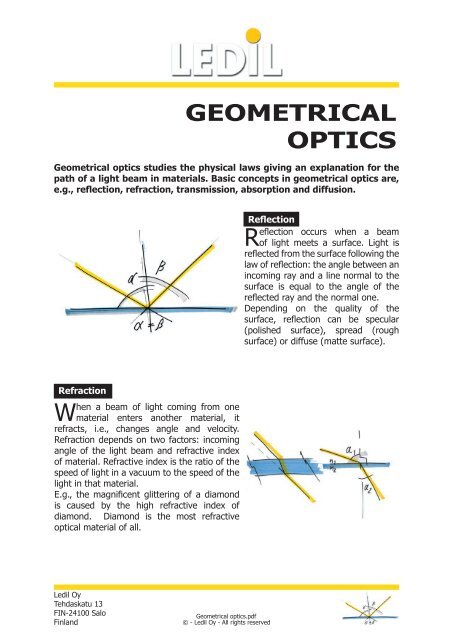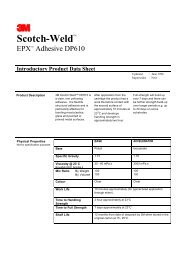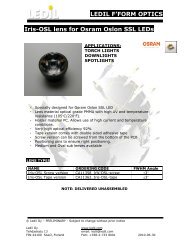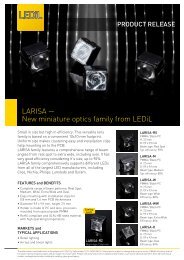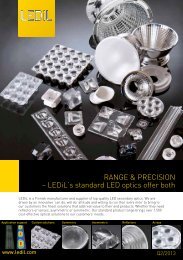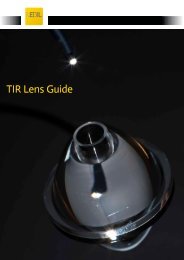Geometrical Optics (pdf) - Ledil
Geometrical Optics (pdf) - Ledil
Geometrical Optics (pdf) - Ledil
Create successful ePaper yourself
Turn your PDF publications into a flip-book with our unique Google optimized e-Paper software.
GEOMETRICAL<br />
OPTICS<br />
<strong>Geometrical</strong> optics studies the physical laws giving an explanation for the<br />
path of a light beam in materials. Basic concepts in geometrical optics are,<br />
e.g., reflection, refraction, transmission, absorption and diffusion.<br />
Reflection<br />
Reflection occurs when a beam<br />
of light meets a surface. Light is<br />
reflected from the surface following the<br />
law of reflection: the angle between an<br />
incoming ray and a line normal to the<br />
surface is equal to the angle of the<br />
reflected ray and the normal one.<br />
Depending on the quality of the<br />
surface, reflection can be specular<br />
(polished surface), spread (rough<br />
surface) or diffuse (matte surface).<br />
Refraction<br />
When a beam of light coming from one<br />
material enters another material, it<br />
refracts, i.e., changes angle and velocity.<br />
Refraction depends on two factors: incoming<br />
angle of the light beam and refractive index<br />
of material. Refractive index is the ratio of the<br />
speed of light in a vacuum to the speed of the<br />
light in that material.<br />
E.g., the magnificent glittering of a diamond<br />
is caused by the high refractive index of<br />
diamond. Diamond is the most refractive<br />
optical material of all.<br />
<strong>Ledil</strong> Oy<br />
Tehdaskatu 13<br />
FIN-24100 Salo<br />
Finland<br />
<strong>Geometrical</strong> optics.<strong>pdf</strong><br />
© - <strong>Ledil</strong> Oy - All rights reserved
Total Internal Reflection<br />
When a beam of light comes from a<br />
material having a greater index of<br />
refraction to one with a lower index of<br />
refraction, it bends away from normal.<br />
When this angle increases, it reaches<br />
finally a point, from which forward all light<br />
is not anymore refracted but reflected.<br />
This phenomenon is used, e.g., in fiber<br />
optics and light guides where light has to<br />
be transported long ways.<br />
Transmission<br />
When a beam of light goes through an object, it is called transmission. The<br />
phenomena that affect light transmission are reflection, refraction, absorption<br />
and diffusion. How much they affect is depending on the object’s material properties<br />
and surface quality.<br />
Absorption and Diffusion<br />
Many materials selectively absorb<br />
more of certain areas of radiation.<br />
Normally absorbed radiation is converted<br />
into heat. Degree of absorption is defined<br />
by material thickness and concentration of<br />
the absorbing component.<br />
When a beam of light hits a rough<br />
surface, it is reflected or transmitted in<br />
many directions. This is called diffusion<br />
or scattering. The amount of diffusion<br />
depends on the difference in refractive<br />
index between the materials and the size<br />
and the geometry of the diffusing particles<br />
compared to the wavelength of the light.<br />
<strong>Ledil</strong> Oy<br />
Tehdaskatu 13<br />
FIN-24100 Salo<br />
Finland<br />
<strong>Geometrical</strong> optics.<strong>pdf</strong><br />
© - <strong>Ledil</strong> Oy - All rights reserved


